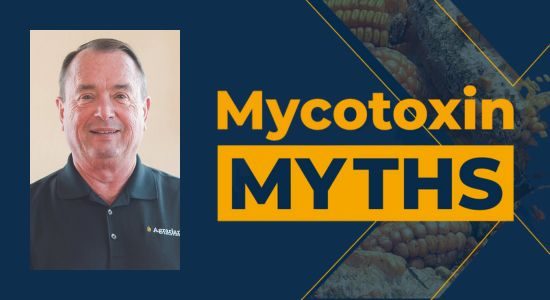Mycotoxin Myths

Written By: John Doerr, Ph.D., PAS, Dpl. ACAP Vice President, Science & Technology
As well-known as mycotoxins have become in animal agriculture, there are some recurring myths needing correction so a producer can make good choices when faced with a possible threat to the herd or flock:
Mycotoxin = aflatoxin. False. Aflatoxins are just one kind of over 2000 known mycotoxins. Zero aflatoxin does not mean that there are no mycotoxins. A corollary is that when a test for 6 or so different mycotoxins is performed and the results are negative, the feed tested is ‘safe’. False. While we don’t see some of the odd mycotoxins very often, or if they are not part of the test panel, the animals may still be at high risk. For example, one called beauvericin has been known for over a decade, but little was known about its effects on domestic species. In a 2016 study, Schoevers [E. J. Schoevers, et al. (2016). Toxicity of beauvericin on porcine oocyte maturation and preimplantation embryo development. Repro. Toxicol. 65:159-69] reported that this toxin has serious impact on developing pig embryos shortly after fertilization of the ovum. At this time, we may not have similar studies for poultry or cattle, but the implication that they are also at risk is reasonable. Does your mycotoxin test include beauvericin?
Monogastrics absorb mycotoxins differently that ruminants. True. But differences occur within each of those groups. Even within one type of animal (e.g., the dairy cow) different breeds have different susceptibilities to specific mycotoxins. And, within a single breed, there is considerable variation animal to animal on absorption and impact, usually dependent on health, environmental stress, genetics, etc. But, almost without exception, all animals do absorb mycotoxins in the same general region of the intestinal tract.
The rumen will detoxify key mycotoxins. False. Early research was performed in vitro with rumen fluid; some research confirms that a portion of deoxynivalenol (DON) is converted to a less toxic form. But zearalenone is converted in the rumen to an alternative form that is many times more estrogenic than the primary molecule. And while some research implied aflatoxins might be broken down, one must then explain how a conversion product of aflatoxin in the liver, aflatoxin M1, can show up in milk.
High levels of mycotoxins are needed to affect animals. False. First exposure may be acute...a sudden problem from a portion of one ingredient for a short time...or chronic...low to moderate levels over a long period of time. Each will impact the herd or flock. And, when there are multiple mycotoxins, low amounts generally produce the most noticeable synergistic effects.
If the toxin is below FDA levels, it’s okay. False. FDA’s primary mission is to protect humans from problems related to their food, and secondarily to protect animals from chemicals that may harm them or contaminate the milk, meat, or eggs they produce. But the line between what causes possible harm to a cow or pig and what impairs efficient production is not clear cut. Whether your Holstein produces 90 lbs of milk or 70 lbs of milk is not FDA’s concern.